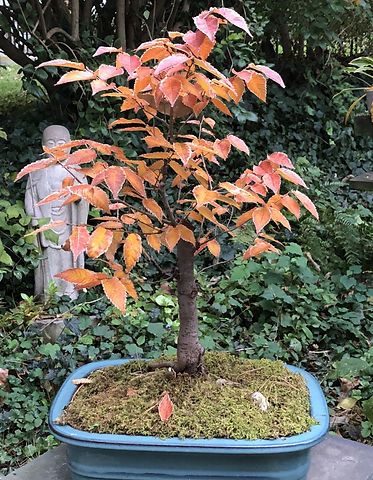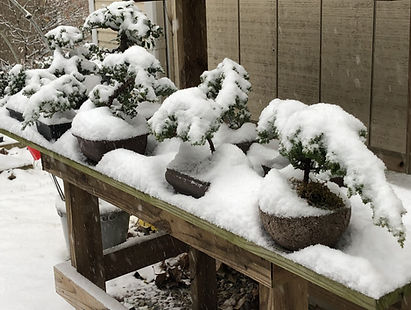Seasonal Tips to help you care for your bonsai - Autumn

Willow Leaf Ficus - Late Spring 2018 Grown Outdoors

Above & Right - Same Willow Leaf Ficus Experiencing Common Autumn Leaf Drop

AUTUMN - TROPICALS(Grown outdoors Spring & Summer)
Many bonsai growers site their tropical bonsai outdoors late spring through early fall. Tropicals prefer temps above 60 degrees Fahrenheit and most will tolerate temps down to 45-50 degrees for a short period of time. When the overnight outdoor temps consistently drop to the 50 degree range it's time to bring your tropical bonsai inside for the winter.
The best location to site your indoor bonsai for the cooler months is near a window. Also, many bonsai devotees, especially those with multiple trees, supplement their lighting needs with fluorescents or LEDs. Here at YDB, we've had success overwintering our tropical bonsai with both fluorescent and LED lighting fixtures. Be mindful NOT to place your bonsai too close to a heat register - the dry air of a heater will quickly desiccate your tree! Your bonsai will also appreciate if you have the capability to add some humidity around your tree; frequent misting, use of humidity trays or a room humidifier will all combat our dry indoor environments.
Another successful practice we've incorporated at YDB is to spray insecticidal soap as a pest preventative on ALL our "incoming" tropical bonsai before they are placed indoors for the winter. Also, reduce the strength and frequency of feeding your bonsai. Weak doses once every 4-6 weeks will more than suffice to see your trees through the fall and winter.
NOTE: Expect some leaf drop on many of the tropical bonsai species that are brought indoors. The immediate change from the brighter outdoor conditions compared to the dry air and lower light of being indoors "slows down" your tree's vigor causing foliage loss. THIS IS NORMAL. Be careful not to over water any bonsai that has experienced foliage drop. Come spring the daylight increases, your tropical bonsai will regain it's vigor and begin putting on new green growth.
TROPICALS (Grown indoors year round)
Siting your tropical bonsai indoors year round is typical with many bonsai growers. Most woody tropicals will thrive indoors if light levels, temperatures and humidity is aligned with the needs of your particular tree. Obviously greenhouses and sunrooms are the best choices to grow any plant, however our homes and offices can easily be adapted to successful bonsai growing environments.
Heating systems, along with the shorter days of Autumn are the challenges indoor bonsai growers need to overcome. The dry winter air caused by our heating systems can be addressed by raising the humidity level - misting your tree 2-3 times per day and setting your tree on a shallow tray with pebbles and water. The evaporation of the tray water will raise the humidity around the bonsai. Make sure your bonsai pots and roots are not sitting IN the tray water; this would quickly result in root rot and the decline of your tree.
Also, understand that the shorter days of Autumn will slow down the growth of your tree. Fertilizer and watering needs through the fall and winter are less than is required during the growing season. Weak doses of feed once every 4-6 weeks are sufficient for your indoor bonsai through the fall and winter.

Dwarf Umbrella Tree - Inner Leaf Drop When Brought Indoors

Chinese Elm - Autumn

Japanese Variegated Zelkova - Autumn

Lace Leaf Japanese Maple - Autumn

HARDY/OUTDOOR (ie Junipers, Maples, Pines, Elms, etc)
Autumn is a time to enjoy the beautiful fall colors of your deciduous bonsai and prepare all outdoor trees for the upcoming winter season. If you are still feeding your outdoor trees, make sure your fertilizer is a low or zero nitrogen blend. Autumn is NOT the time to encourage new green growth - This is a sure recipe to invite die back and potential problems the following spring. At YDB we stop feeding our hardy bonsai in early November. Continue watering your outdoor bonsai regularly through Autumn ensuring your trees do not dry out.
Be mindful of unseasonably warm or very cold temps that seem to catch us by surprise every Autumn. During a warm spell make sure your tree's root ball does not dry out. When an unforeseen cold blast hits, ensure your trees are protected from steady freezing winds which could easily desiccate your bonsai. Pay particular attention to broad leaf evergreens (ie Azaleas, Boxwoods, etc) and some less cold hardy deciduous trees (ie Bald Cypress, Trident Maples, Chinese Elms, etc). Also keep a close eye that any bonsai in very small pots are not subject to strong, cold winds - they can quickly dry out.
Autumn is also the time to think about planning your winter storage for your outdoor bonsai. An ideal location for overwintering your hardy bonsai will have no direct sunlight and give protection against strong winds. Additional winter care guidelines will follow shortly with our upcoming winter "tips".
Note of Reference: Any weather related advice from YDB pertains to the suburban Philadelphia region; hardiness zones 6b-7a.
Dawn Redwood - Autumn

Japanese Variegated Zelkova - Autumn
If you need help with any of your bonsai chores, Yellowdog Bonsai can provide all the necessary services to keep your bonsai healthy and thriving. Contact Bob at yellowdogbonsai@gmail.com or 267-679-4929

Junipers & Elms - Unexpected Autumn Snowfall